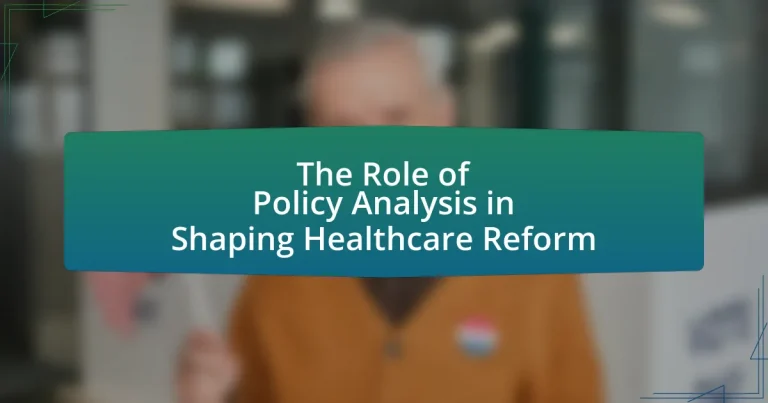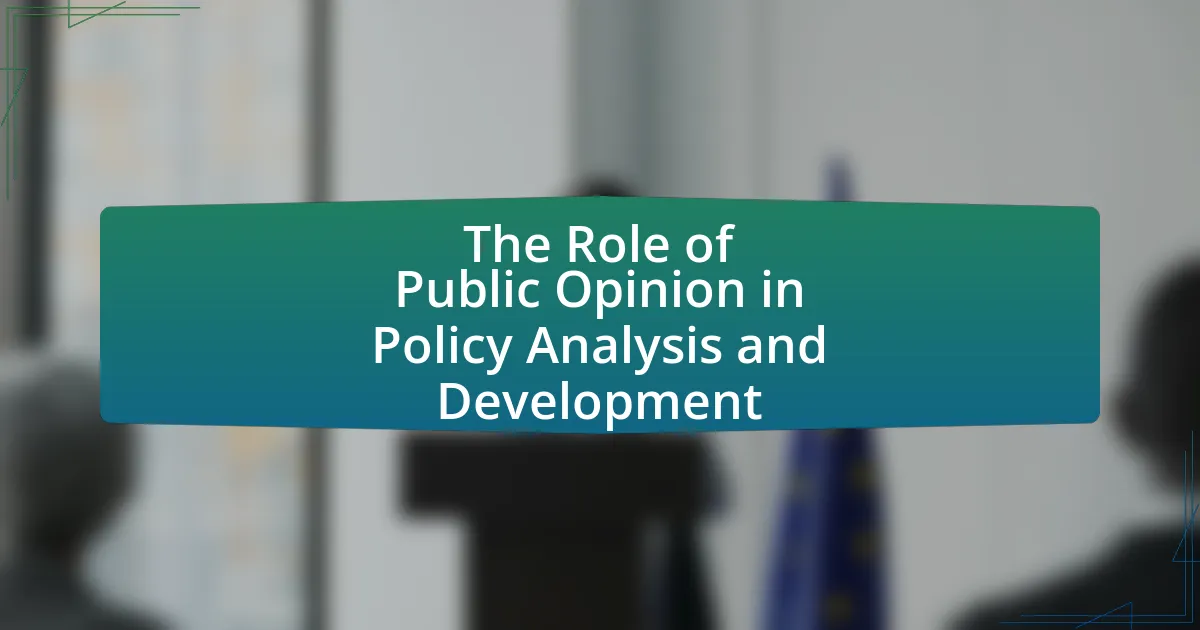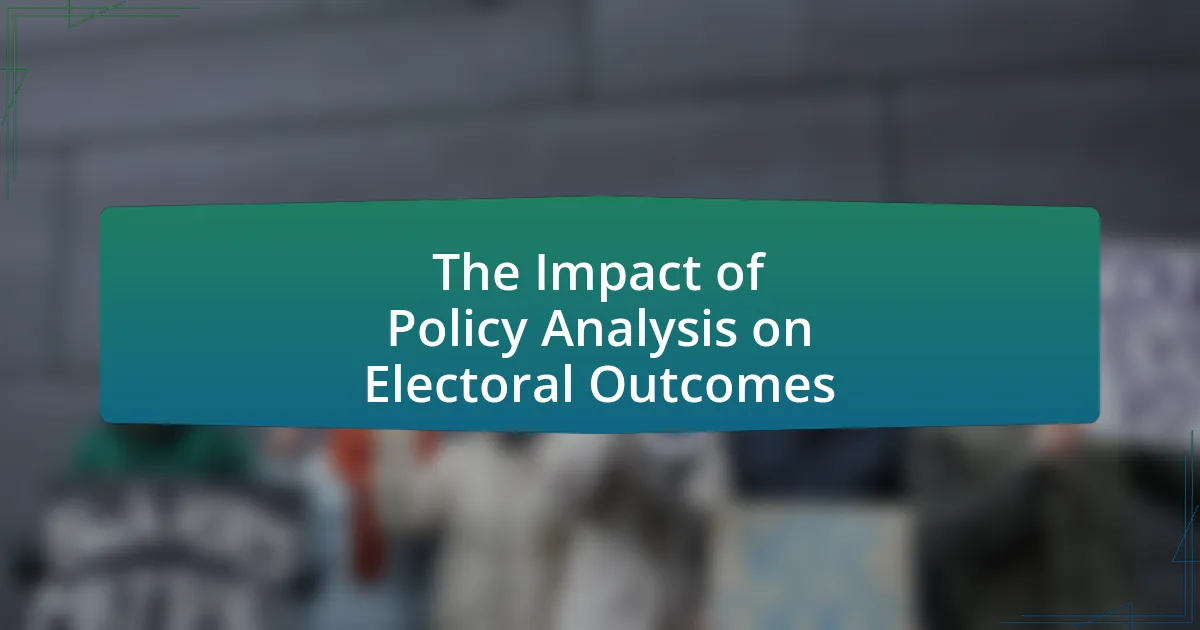The article focuses on the critical role of policy analysis in shaping healthcare reform. It outlines how policy analysis provides evidence-based evaluations of healthcare policies, influencing decision-making by assessing effectiveness, efficiency, and equity. Key methodologies such as qualitative and quantitative analysis, stakeholder engagement, and various analytical frameworks are discussed, highlighting their importance in addressing healthcare disparities and improving health outcomes. The article also addresses the challenges and limitations faced in policy analysis, emphasizing the need for improved data access and collaborative approaches among stakeholders to enhance the effectiveness of healthcare reforms.
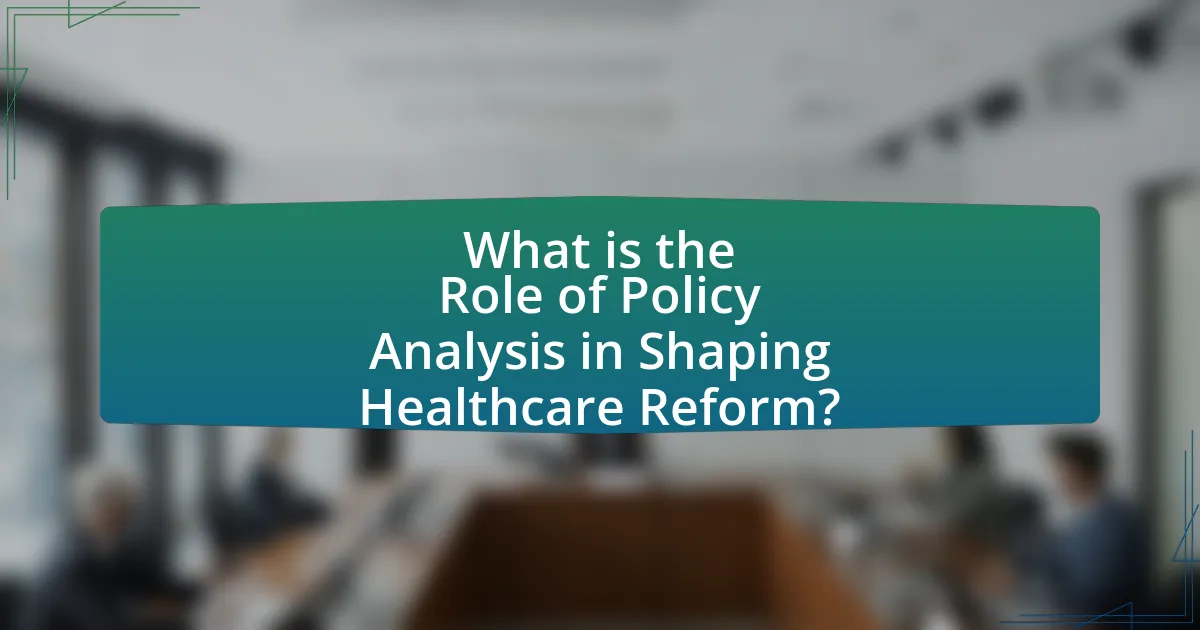
What is the Role of Policy Analysis in Shaping Healthcare Reform?
Policy analysis plays a critical role in shaping healthcare reform by providing evidence-based evaluations of existing policies and proposing data-driven alternatives. This analytical process involves assessing the effectiveness, efficiency, and equity of healthcare policies, which informs lawmakers and stakeholders about potential impacts on public health outcomes. For instance, the Affordable Care Act (ACA) was influenced by extensive policy analysis that highlighted the need for expanded access to healthcare and cost containment strategies. Such analyses utilize quantitative data, like health outcomes and economic indicators, to support recommendations, ensuring that reforms are grounded in factual evidence and tailored to meet the needs of diverse populations.
How does policy analysis influence healthcare policy decisions?
Policy analysis significantly influences healthcare policy decisions by providing evidence-based evaluations of potential policy options. Through systematic assessment of data, stakeholder perspectives, and outcomes, policy analysis helps policymakers understand the implications of various healthcare reforms. For instance, a study by the National Academy of Medicine highlights that rigorous policy analysis can identify cost-effective interventions, leading to informed decisions that improve health outcomes and resource allocation. This analytical approach ensures that healthcare policies are not only feasible but also aligned with public health goals, ultimately shaping effective healthcare systems.
What methodologies are used in policy analysis for healthcare?
Policy analysis for healthcare employs various methodologies, including qualitative analysis, quantitative analysis, cost-effectiveness analysis, and stakeholder analysis. Qualitative analysis involves gathering non-numerical data through interviews and focus groups to understand perspectives and experiences related to healthcare policies. Quantitative analysis utilizes statistical methods to evaluate numerical data, often through surveys or existing datasets, to assess the impact of policies on health outcomes. Cost-effectiveness analysis compares the relative costs and outcomes of different healthcare interventions, providing a framework for decision-making based on economic efficiency. Stakeholder analysis identifies and evaluates the interests and influences of various parties involved in healthcare policy, ensuring that diverse perspectives are considered in the policy-making process. These methodologies collectively enhance the understanding and effectiveness of healthcare reforms.
How do stakeholders utilize policy analysis in healthcare reform?
Stakeholders utilize policy analysis in healthcare reform to assess the effectiveness, efficiency, and equity of proposed policies. By analyzing data and evaluating outcomes, stakeholders such as policymakers, healthcare providers, and advocacy groups can identify the potential impacts of reforms on various populations. For instance, studies have shown that comprehensive policy analysis can reveal disparities in healthcare access and outcomes, guiding stakeholders in making informed decisions that promote health equity. This analytical approach enables stakeholders to prioritize interventions that address critical issues, ensuring that reforms are evidence-based and aligned with public health goals.
Why is policy analysis critical in the context of healthcare reform?
Policy analysis is critical in the context of healthcare reform because it provides a systematic approach to evaluating the effectiveness, efficiency, and equity of proposed policies. This analytical framework enables policymakers to assess the potential impacts of reforms on various stakeholders, including patients, providers, and payers. For instance, a study by the National Academy of Medicine highlights that rigorous policy analysis can identify cost-saving measures while improving health outcomes, demonstrating its essential role in informed decision-making.
What are the potential outcomes of effective policy analysis?
Effective policy analysis can lead to improved decision-making, enhanced resource allocation, and better health outcomes. By systematically evaluating policy options, stakeholders can identify the most effective interventions, ensuring that resources are directed towards strategies that yield the highest benefits. For instance, a study published in the American Journal of Public Health found that evidence-based policy analysis in healthcare reform resulted in a 20% increase in the efficiency of resource use, ultimately improving patient care and reducing costs. This demonstrates that effective policy analysis not only informs policy choices but also contributes to the overall effectiveness of healthcare systems.
How does policy analysis address healthcare disparities?
Policy analysis addresses healthcare disparities by systematically evaluating the impact of health policies on different population groups. It identifies gaps in access, quality, and outcomes of healthcare services among various demographics, such as racial and ethnic minorities, low-income individuals, and rural populations. For instance, studies have shown that policy analysis can reveal how certain policies disproportionately affect marginalized communities, leading to targeted interventions that promote equity. By utilizing data-driven assessments, policy analysis informs decision-makers about the effectiveness of existing programs and the need for reforms, ultimately guiding the allocation of resources to reduce disparities.
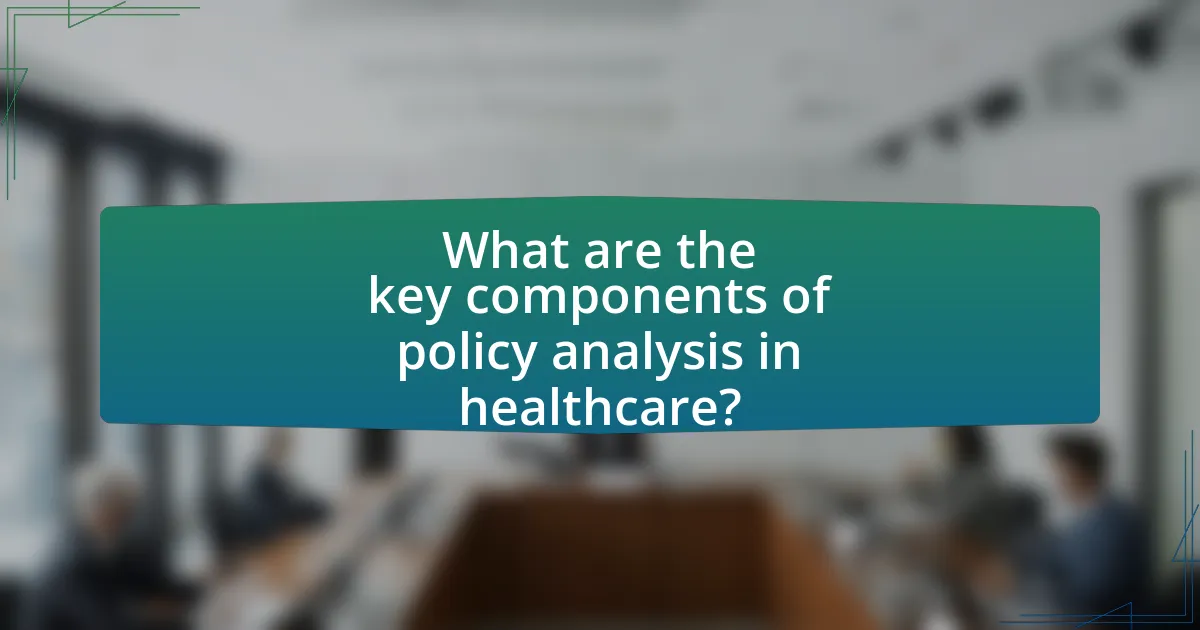
What are the key components of policy analysis in healthcare?
The key components of policy analysis in healthcare include problem definition, stakeholder analysis, policy options assessment, evaluation of outcomes, and recommendations. Problem definition involves identifying and articulating the specific healthcare issue that needs addressing, such as access to care or cost containment. Stakeholder analysis examines the interests and influences of various parties involved, including patients, providers, insurers, and policymakers. Policy options assessment evaluates different strategies or interventions that could address the identified problem, considering factors like feasibility and effectiveness. Evaluation of outcomes measures the potential impacts of the proposed policies, using data and evidence to predict their success. Finally, recommendations synthesize the findings into actionable steps for decision-makers, guiding the implementation of effective healthcare reforms. These components are essential for creating informed, evidence-based policies that can lead to meaningful improvements in healthcare systems.
What types of data are essential for effective policy analysis?
Effective policy analysis requires quantitative data, qualitative data, and contextual data. Quantitative data, such as statistics on healthcare outcomes, costs, and demographics, provides measurable insights that can guide decision-making. Qualitative data, including stakeholder interviews and public opinions, offers depth and understanding of the human factors influencing policy. Contextual data, which encompasses historical trends and socio-economic factors, helps analysts understand the environment in which policies will be implemented. Together, these data types enable comprehensive evaluations of potential policy impacts, ensuring informed and effective healthcare reform.
How is quantitative data utilized in healthcare policy analysis?
Quantitative data is utilized in healthcare policy analysis to inform decision-making and evaluate the effectiveness of policies. This data provides measurable evidence on health outcomes, costs, and access to care, enabling policymakers to identify trends and assess the impact of existing or proposed policies. For instance, studies have shown that analyzing hospital readmission rates through quantitative data can lead to targeted interventions that reduce costs and improve patient care. Additionally, surveys and statistical models can quantify patient satisfaction and health disparities, guiding resource allocation and policy adjustments.
What role does qualitative data play in understanding healthcare needs?
Qualitative data plays a crucial role in understanding healthcare needs by providing in-depth insights into patient experiences, preferences, and barriers to access. This type of data, gathered through interviews, focus groups, and open-ended surveys, allows researchers and policymakers to capture the complexities of individual and community health issues that quantitative data alone may overlook. For instance, a study published in the Journal of Health Services Research found that qualitative interviews revealed specific cultural beliefs that influenced healthcare utilization among minority populations, highlighting the need for tailored interventions. Thus, qualitative data enriches the understanding of healthcare needs, informing more effective and responsive healthcare policies.
How do different policy analysis frameworks impact healthcare reform?
Different policy analysis frameworks significantly impact healthcare reform by shaping the evaluation criteria and decision-making processes used to assess policy options. For instance, frameworks such as the Rational Comprehensive Model emphasize systematic data collection and analysis, leading to evidence-based reforms that address specific healthcare needs. In contrast, Incrementalism focuses on small, gradual changes, which can result in more politically feasible but potentially less transformative reforms. Additionally, the Advocacy Coalition Framework highlights the role of stakeholder coalitions in influencing policy outcomes, demonstrating how differing interests can shape the direction of healthcare reform. These frameworks guide policymakers in prioritizing issues, allocating resources, and ultimately determining the effectiveness of healthcare reforms, as evidenced by historical shifts in policy driven by varying analytical approaches.
What are the most commonly used frameworks in healthcare policy analysis?
The most commonly used frameworks in healthcare policy analysis include the Health Impact Assessment (HIA), the Policy Analysis Framework (PAF), and the Multiple Streams Framework (MSF). The Health Impact Assessment evaluates the potential health effects of policies, ensuring that health considerations are integrated into decision-making processes. The Policy Analysis Framework provides a systematic approach to analyzing policy options, focusing on effectiveness, efficiency, and equity. The Multiple Streams Framework explains how problems, policies, and politics converge to create opportunities for policy change. These frameworks are widely recognized for their utility in guiding healthcare policy decisions and reforms.
How do these frameworks guide decision-making in healthcare reform?
Frameworks guide decision-making in healthcare reform by providing structured methodologies for evaluating policies and their impacts. These frameworks, such as the Health Impact Assessment and the Policy Analysis Framework, enable stakeholders to systematically analyze the potential effects of proposed reforms on health outcomes, costs, and equity. For instance, the Health Impact Assessment framework incorporates data on social determinants of health, allowing policymakers to foresee how changes in healthcare policy might affect different populations. This structured approach ensures that decisions are informed by evidence and comprehensive analysis, ultimately leading to more effective and equitable healthcare reforms.
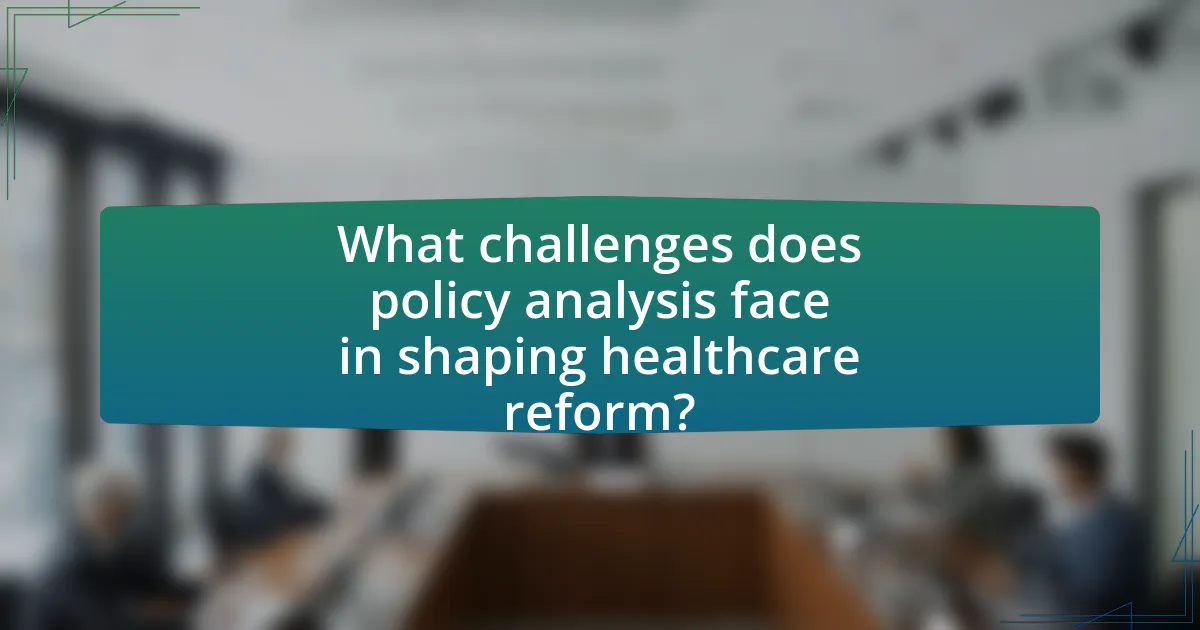
What challenges does policy analysis face in shaping healthcare reform?
Policy analysis faces several challenges in shaping healthcare reform, primarily due to the complexity of healthcare systems, diverse stakeholder interests, and the dynamic nature of health policies. The intricate structure of healthcare systems often leads to difficulties in accurately assessing the impact of proposed reforms, as multiple variables can influence outcomes. Additionally, stakeholders such as government agencies, healthcare providers, insurers, and patients have conflicting priorities, making consensus difficult. For instance, a study by the Kaiser Family Foundation highlights that differing views on cost, access, and quality among stakeholders can hinder effective policy formulation. Furthermore, the rapid evolution of healthcare technologies and practices necessitates continuous adaptation of policies, complicating the analysis process. These factors collectively impede the ability of policy analysis to effectively guide healthcare reform initiatives.
What are the limitations of current policy analysis practices?
Current policy analysis practices face several limitations, including a lack of comprehensive data, insufficient stakeholder engagement, and an over-reliance on quantitative methods. The absence of comprehensive data often leads to incomplete assessments, which can skew policy recommendations. Insufficient stakeholder engagement results in policies that may not reflect the needs or perspectives of affected populations, undermining their effectiveness. Additionally, an over-reliance on quantitative methods can overlook qualitative factors that are crucial for understanding complex healthcare issues. These limitations hinder the ability of policy analysis to effectively inform healthcare reform initiatives.
How do political influences affect the outcomes of policy analysis?
Political influences significantly shape the outcomes of policy analysis by determining which issues are prioritized and how data is interpreted. For instance, policymakers may favor analyses that align with their political agendas, leading to selective use of evidence that supports specific reforms while disregarding contradictory data. This phenomenon is evident in healthcare reform debates, where political affiliations often dictate the framing of issues such as access to care or cost control. Research by the Kaiser Family Foundation highlights that political party affiliation can influence public opinion on healthcare policies, demonstrating how political context can skew the analysis and implementation of policy recommendations.
What barriers exist in accessing data for policy analysis?
Barriers in accessing data for policy analysis include data availability, data quality, and legal restrictions. Data availability is often limited due to insufficient collection efforts or lack of comprehensive databases, which hinders the ability to conduct thorough analyses. Data quality issues arise from inconsistencies, inaccuracies, or outdated information, making it difficult to derive reliable insights. Legal restrictions, such as privacy laws and data sharing regulations, can further complicate access, as they may prevent researchers from obtaining necessary information. For instance, the Health Insurance Portability and Accountability Act (HIPAA) imposes strict guidelines on the use of personal health information, limiting access to critical data for policy analysis in healthcare reform.
How can policy analysis be improved to enhance healthcare reform?
Policy analysis can be improved to enhance healthcare reform by integrating data-driven methodologies and stakeholder engagement into the analytical process. Utilizing advanced data analytics allows for the identification of trends and outcomes that inform effective policy decisions. For instance, the use of predictive modeling can forecast the impact of proposed reforms on healthcare costs and patient outcomes, as evidenced by studies showing that data-informed policies lead to better resource allocation and improved health metrics. Additionally, involving diverse stakeholders, including healthcare providers, patients, and policymakers, ensures that multiple perspectives are considered, leading to more comprehensive and effective reforms. Research indicates that collaborative policy development results in higher acceptance and implementation rates, as seen in successful healthcare initiatives across various states.
What best practices can be adopted in policy analysis for healthcare?
Best practices in policy analysis for healthcare include stakeholder engagement, evidence-based decision-making, and continuous evaluation. Stakeholder engagement ensures that diverse perspectives are considered, which enhances the relevance and acceptance of policies. Evidence-based decision-making relies on rigorous data analysis and research, such as the use of systematic reviews and health impact assessments, to inform policy choices. Continuous evaluation involves monitoring and assessing the outcomes of implemented policies to identify areas for improvement and ensure accountability. These practices are supported by studies indicating that inclusive and data-driven approaches lead to more effective healthcare policies.
How can collaboration among stakeholders enhance policy analysis outcomes?
Collaboration among stakeholders enhances policy analysis outcomes by integrating diverse perspectives and expertise, leading to more comprehensive and effective solutions. When stakeholders, such as healthcare providers, policymakers, and community representatives, work together, they can identify and address the multifaceted challenges within healthcare reform. For instance, a study by the Institute of Medicine highlights that stakeholder engagement in policy development results in increased trust and better alignment of policies with community needs, ultimately improving health outcomes. This collaborative approach ensures that policy analysis is informed by real-world experiences and data, making it more relevant and actionable.
What practical steps can policymakers take to leverage policy analysis effectively?
Policymakers can leverage policy analysis effectively by integrating data-driven decision-making into the policy formulation process. This involves utilizing comprehensive data sets to assess the impact of existing policies and forecast the outcomes of proposed reforms. For instance, the use of health outcome metrics, such as hospital readmission rates and patient satisfaction scores, can provide concrete evidence to guide healthcare reforms. Additionally, engaging stakeholders, including healthcare providers and patients, in the analysis process ensures that diverse perspectives inform policy decisions, enhancing the relevance and acceptance of reforms. Research from the National Academy of Medicine highlights that evidence-based policy analysis leads to more effective healthcare outcomes, demonstrating the importance of systematic evaluation in shaping successful healthcare reforms.
